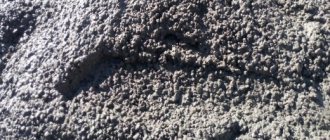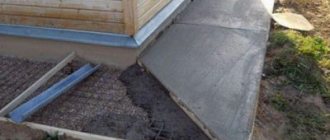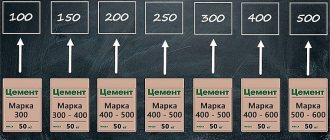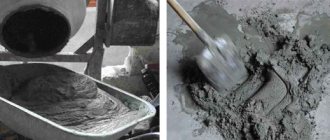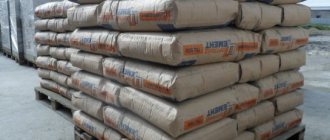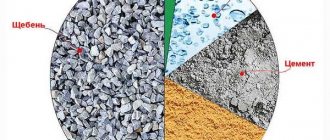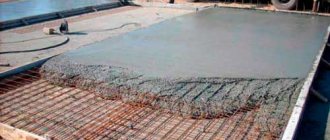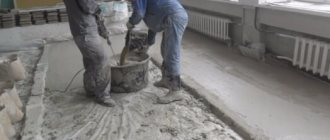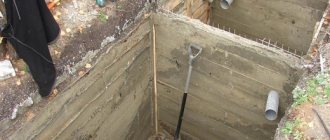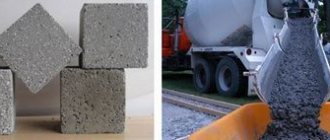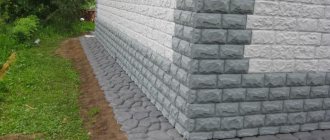General characteristics of concrete
Concrete is an artificial stone used in almost all areas of construction. When hardened, the mixture of water, binder and fillers forms a durable monolith with valuable qualities:
- high density;
- frost resistance;
- waterproof.
The properties of concrete are determined by the grade, which indicates the average compressive strength in MPa at the age of 28 days. To carry out calculations, another characteristic is more often used - concrete class. It is associated with the brand, but unlike it, it denotes ensured strength and describes the material more broadly.
It is possible to load concrete that has not completely hardened only after preliminary calculation of the loads. Formwork is allowed to be removed:
- from the side surfaces of the structure after 6-72 hours;
- load-bearing panels, columns, floors - 70-80 hours.
Important. When making concrete with your own hands, chemical additives are added to the mixture to improve its properties. You need to work with substances carefully, without deviating from the manufacturer’s recipe.
We also recommend reading articles about do-it-yourself foundations, which foundation is suitable for your region and soil construction.
Methods for mixing concrete
There are two ways to prepare building concrete yourself:
- Mix the solution by hand;
- Use a concrete mixer for mixing.
Manual mixing of concrete
- First pour the required amount of sand into a clean container;
- Strictly observing the proportions, pour cement on top. Mix both fillers well until their color becomes uniform;
- Measure out the required amount of water and add it in small portions to a container with sand and cement, while simultaneously distributing and mixing the mixture over the entire area. The result should be a gray mass without lumps and visible residues of sand and cement;
- The final step is to add crushed stone to the resulting solution. Kneading should occur until each pebble is covered with the solution. To give the concrete the necessary plasticity, add water if necessary.
The disadvantages of the manual method include the following:
- Quite a labor-intensive and lengthy process;
- Immediate use of the solution after mixing. Otherwise, the solution may begin to delaminate, which will lead to a deterioration in its quality.
Components
Concrete has been used for about 4 thousand years. Its composition has undergone changes during this time and has become more perfect. If in ancient times majestic structures were erected from binder with aggregates, now it is an affordable and easy-to-work material for all types of construction.
Cement - everything about it
The most common binder for making concrete is cement. It is produced in cement factories from clay, lime and gypsum by firing and then grinding into powder. Depending on the mineral composition, the binder is classified into Portland cement, Portland slag cement, aluminous, pozzolanic, magnesian and other types. The grade of material indicates the compressive strength of cement stone in MPa and can range from M25 to M600.
Most often, Portland cement PC brand M400 or M500 is used to prepare concrete with your own hands. This is a universal material with sufficient strength and frost resistance.
Important. Over time, the activity of the binder decreases at a rate of 1 mark per 3 months, that is, instead of the initial M500, in fact there will be M400. You only need to buy fresh cement stored in a dry warehouse.
How to choose sand
Sand fills the pores in concrete between particles of crushed stone or gravel and contributes to the uniform distribution of internal stresses in the mixture. When the cement hydrates, the grains of sand are enveloped in a gel-like adhesive, forming a strong structure when hardened. Sand for high-quality concrete should not be too fine or coarse - the optimal grain size is 2-2.5 mm. The content of dust particles in the filler is limited to 3%. Lumps of clay and organic impurities are not allowed.
The most commonly used sand is quarry sand from nearby mines. In places where there are rivers, washed river sand is mined for making concrete and other construction needs. The use of available fine aggregate reduces the consumption of more expensive binders and reduces the cost of the mixture.
Concrete components
Preparing concrete by hand
Cement
Cement
Cement performs a binding function for all other components of the concrete mortar, and the strength of the concrete itself directly depends on its quality. In private construction, cement grades M400 and M500 are most in demand. When purchasing cement, you should be aware that it loses its qualities if stored for a long time or improperly. Already a month after production, the binding properties of cement decrease by 10%, after six months - by 50%, after a year it is not recommended to use it at all. But even fresh cement will become unsuitable for use if it becomes damp, so it must be stored in a dry place.
Cement
Sand
Sand
is the second most important component of concrete mortar. In rare cases, it is replaced with slag, while standard concrete is always mixed with sand. It is best to use coarse river sand without various impurities. If only ordinary fine sand is available, it should not contain clay, earth or silt, which reduce the adhesion of the solution to the filler. Before mixing, the sand must be sifted to remove all excess.
Aggregate
Crushed stone as a filler for concrete
The best filler for concrete mortar is crushed stone with dimensions from 5 to 35 mm. Often crushed stone is replaced with gravel, and a little less often with expanded clay. It is very important that the surface of the aggregate is rough, then its adhesion to the cement will be as strong as possible. To compact the mixture, you need to take aggregate of different fractions. Like sand, the aggregate must be clean, so it should be poured onto a prepared and compacted area or on a spread tarp.
Supplements
Plasticizers
To give concrete frost resistance, water resistance and other useful properties, plasticizers are used. They ensure the setting of the solution at low temperatures, increase its plasticity or, conversely, impart viscosity. They should be used only if it is really necessary, and you should strictly adhere to the instructions for their use and observe the proportions.
Construction fiber
Steel fiber fiber
If a thin screed or a screed on an unstable base is required, reinforcing fibers are mixed into the concrete solution. They are made of polyvinyl chloride and polypropylene; they have low strength, but are excellent at avoiding cracking of concrete. In standard foundations and screeds, reinforcing substances are not needed.
Prices for cement and basic mixtures
Cement and base mixtures
What is better to use - crushed stone or gravel?
It is impossible to make proper concrete with your own hands without coarse aggregate, the share of which in the finished mixture is up to 45%. Thanks to the introduction of crushed stone or gravel into the solution, the mixture is compacted, creating a strong internal frame that can withstand heavy loads. Ready-made concrete reduces shrinkage and cracking and increases water resistance.
Despite the external similarity of gravel and crushed stone, these types of aggregate differ both in origin and in some characteristics:
- Gravel is formed as a result of weathering of hard rocks and consists of rounded fragments up to 50 mm in size. It is decorative and has low bulk density.
- Crushed stone is obtained by crushing mountain minerals - granite, limestone or the same gravel, waste from metallurgical production. After sorting on a screen, the stones are distributed into fractions from 5 to 70 mm. The bulk density is higher than that of gravel.
Coarse aggregate can be made from construction waste, then it is called secondary crushed stone. The inexpensive material is used for filling roads, strengthening soils, and producing low-grade concrete. Research conducted on concrete using various aggregates has established that concrete based on crushed stone has greater strength, frost resistance and durability. Stones mined by crushing have a rough surface and a close to cubic shape, which ensures high density and strong adhesion to cement mortar when laid.
Natural gravel with rounded smooth edges does not adhere well to the components of the mixture. It is best used for landscape design or concreting lightly loaded structures - support posts, garden paths.
Important. The highest quality crushed stone is produced from granite rocks. It is superior to analogues made from other materials in strength, hardness and frost resistance.
Chemical additives
Chemical additives improve the quality of concrete and make it easier to lay. They are produced in the form of liquids, pastes, suspensions, powder or monolithic blocks.
Chemical additives affect the properties of concrete in different ways. There are additives with a narrow effect:
- plasticizing;
- water-reducing;
- stabilizing;
- to maintain mobility;
- hardening accelerators or retarders;
- to increase strength, impermeability;
- reducing the aggressive impact on reinforcement;
- increasing frost resistance or hydrophobicity.
In addition, active substances sometimes have additional (positive or negative) effects. When preparing the mixture, you must strictly adhere to the dosage and application technology in order to achieve a predictable result.
At home, when making concrete with your own hands, you sometimes use self-prepared additives. There are many recipes for supposedly effective plasticizers or antifreeze agents. But since their effect has not been tested in laboratory conditions, it is impossible to say with certainty about the positive effect on the properties of concrete.
But independent experiments often produce long-term consequences in the form of active corrosion, the appearance of fungi, efflorescence stains or other unpleasant phenomena. The price of chemical additives is low, and the consumption does not exceed a few%, so it is not worth taking risks using homemade products.
What durable concrete is made from - composition and features of the components of the concrete solution
Many private owners have no doubt that they know the recipe and technology for preparing high-quality concrete. However, the first cracks that appear on the foundation or blind area after winter frosts indicate an inflated self-esteem of these “masters.” That is why it is advisable to start studying the process of preparing concrete yourself from the basics.
Composition and features of concrete mortar components
So, let's start with the components that make up the base of concrete. The concrete mixture contains the following ingredients:
- binder - Portland cement. It is manufactured at industrial enterprises that control product quality;
- filler - crushed stone or gravel, as well as sand. These materials are purchased individually and do not always meet the requirements of regulatory documentation;
- process water that does not contain foreign impurities. You should not introduce water from an unknown reservoir, the composition of which is not determined, into the concrete mixture;
- special additives. Modifiers allow you to change fluidity, provide the required plasticity, increase frost resistance and reduce setting time.
If you want to get durable concrete, you do not need to use raw materials of dubious origin, the quality of which is not confirmed by certificates of conformity. Before studying the technological features of preparing a concrete solution and becoming familiar with the recipe, we will dwell in detail on the requirements for the components included in the concrete mixture.
Cement for preparing mortar
Everyone knows that concrete is made from cement. It acts as a binding component in the concrete mixture. Mostly private developers use M400 cement or M500 cement. The strength characteristics of grade four hundred and five hundred cement make it possible to use this building material for preparing concrete in the field of housing construction. For the manufacture of building structures that can withstand increased loads, concrete is used, which contains M600 cement.
Cement acts as a binding component in the concrete mixture
When selecting Portland cement for the production of a concrete mixture, you need to pay attention to the following characteristics of the binder:
- strength properties affecting the load capacity of concrete after hardening;
- cement density, depending on the date of manufacture of the material and its storage conditions;
- the size of the powder fraction, which determines the setting time;
- corrosion resistance, important for structures located in humid environments;
- sulfate resistance, ensuring preservation of the concrete structure upon contact with salts;
- moisture resistance, which makes it difficult for moisture to penetrate deep into the concrete;
- frost resistance, which determines the possibility of using concrete under sudden temperature changes.
The introduction of modifying additives and plasticizers makes it possible to give cement the required performance properties, which significantly increases the cost of cement powder.
When purchasing Portland cement, pay attention to the following points:
It is necessary to pay attention to the strength properties of cement
- date of manufacture of the binder;
- integrity of packaging containers;
- uniformity of powder consistency;
- uniform color of cement;
- absence of foreign particles and lumps;
- availability of certificates of conformity.
The strength characteristics of a building material are measured in kg/cm2 and decrease as the cement’s shelf life expires.
Changes in strength properties occur as follows:
- during the first two months after cement production, the strength corresponds to the value declared by the manufacturer;
- after 60 days from the date of manufacture, the strength decreases by 20% of the original value;
- 6 months after packaging the cement in bags, the strength of the material does not exceed 70% of the initial one;
- within 12 months of storage, the loss of strength is half the base value.
It is not advisable to purchase caked cement, a long period of time has passed since its manufacture.
What is the best sand to use?
The correct choice of sand used as fine aggregate affects the properties of the concrete mixture.
The properties of the concrete mixture are influenced by the correct choice of sand.
When ordering sand for preparing concrete, pay attention to the quality of the material:
- sand particle size. It is 1.5-4 mm;
- absence of clay particles. The permissible clay concentration is no more than 3%;
- content of fine fractions with a size of no more than 0.6 mm, not exceeding 3%;
- bulk weight of sand, the minimum value of which is 1.4 t/m3.
The main indicators of sand quality are the minimum concentration of dust fraction and clay particles. To remove dust and clay inclusions, wash the sand under water pressure.
To prepare concrete, various types of construction sand are used:
- obtained by career means. Such material often contains an increased amount of clay and limestone particles, which negatively affects the quality of concrete. Concrete begins to collapse as the volume of clay saturated with moisture increases;
- river sand, which differs from quarry material in the absence of foreign inclusions. River sand is characterized by a homogeneous structure, providing a slight deviation in particle sizes in the overall mass of no more than 2 mm.
When choosing sand for mixing concrete, you should give preference to the more expensive alluvial material, which is superior to quarry sand in purity. It is allowed to use quarry material cleaned by the wet method.
Crushed stone or gravel - what to use as the main filler
It does not matter what material is used as coarse aggregate - gravel or crushed stone.
Crushed stone is considered the best filler for concrete mortar
Both building materials are extracted by quarrying from various types of non-metallic rocks:
- dolomite stone;
- gravel boulders;
- natural granite.
Then the extracted material is crushed using special equipment, followed by sorting into fractions. The filler size ranges from 5 to 40 mm. Medium-fraction filler with a size of 10-35 mm is most in demand. It is used for the construction of foundations.
The filler has the following performance characteristics:
- increased strength;
- frost resistance;
- homogeneous grain structure.
In terms of cost, granite crushed stone is the most expensive, while dolomite and gravel materials have an affordable price. However, they are inferior in strength to granite filler.
Filler of different fractions must be taken to compact the mixture
There are certain features of using the filler:
- dolomite crushed stone is part of lightweight concrete class B15;
- gravel material allows you to achieve the strength of concrete B25;
- The strength of concrete increased to B30 is ensured by granite filler.
You should pay attention to the level of radioactive background, which is increased in granite crushed stone. If radiation levels are increased to class II, it is not allowed to use crushed granite stone for housing construction. This material is only suitable for road construction.
Use of special additives to ensure concrete quality
To impart certain characteristics to the concrete solution, special components are introduced during mixing. Professional builders call such additives plasticizers.
They give concrete special properties:
- increase the strength characteristics of the monolith;
- ensure the workability of the concrete mixture;
- prolong the setting period of the solution;
- change the duration of the set of operational strength;
- prevent the possibility of the solution freezing at negative temperatures.
When introducing plasticizers into a concrete solution, it is important to observe the proportions.
To give concrete the necessary properties, it is important to observe the proportions when introducing plasticizers into the concrete solution.
Quality and required quantity of water
When discussing how to make a concrete solution, you should pay attention to the quality of the water added to the solution.
It, like other components, is subject to special requirements. Water should not contain:
- organic inclusions;
- animal and plant pollution;
- acidic and alkaline components.
It is not allowed to use swampy water, as well as liquids containing chemicals, oils and petroleum products. The best water option for preparing concrete is tap water. To obtain the required conditions, you should add a volume of water not exceeding a fifth of the total mass of the solution. With this moisture content in the concrete mixture, the normal course of the hydration process is ensured. The concentration of liquid in the concrete mixture affects the plasticity of the solution.
The plasticity of the solution is affected by the concentration of liquid in the concrete mixture.
How to mix - proportions
Optimal proportions and the correct mixing mode are the key to ensuring that the concrete turns out homogeneous and plastic, and after hardening it will have the required strength.
Material requirements
The cement must be fresh and not stale. The grade is selected based on the rule that it is 2-2.5 times higher than the specified strength of concrete. For example, for concrete M200 you will need Portland cement M400-M500.
Crushed stone must correspond to the purpose of the structures:
- For foundations, floors, columns, crushed granite or gravel is suitable, mixed fraction 5-20 or 5-40 mm, with low flakiness - containing flat or needle-like stones. Larger inclusions fill the mixture unevenly, thereby deteriorating its quality.
- Natural gravel can be used for paths, platforms, supports for gazebos or canopies. It is inexpensive and easier to prepare concrete by hand.
Water interacts with all particles of the mixture, so it must be clean, with a normal pH. Containing salts, oils and petroleum products is not allowed. Do not use sea water or sewage.
The required amount of water depending on the filler in the photo:
Proportions
The ratio of materials depends on factors:
- expected brand of solution;
- size and porosity of aggregates;
- type and brand of cement.
To prepare concrete with your own hands, the proportions of dry ingredients can be determined using special tables:
So, to prepare the most popular M200 concrete, you will need 10 liters of M400 cement, 25 liters of sand and 42 liters of crushed stone. From this amount of materials you will get 54 liters of the finished mixture, the volume is reduced due to compaction.
The amount of water is not indicated in the tables, since it depends on the initial moisture content of the materials. In any case, the liquid should be no more than 0.4-0.75 by weight of cement. For 10 liters of PC you will need 4-7.5 liters of water.
Important. It is not recommended to exceed the dose, since excess water slows down setting, promotes severe shrinkage and the formation of cracks during hardening.
Plasticizers will help increase the elasticity of the mixture. Additives make it easier to mix and place concrete into formwork while maintaining the desired water-cement ratio.
Mixing in a concrete mixer
Concrete prepared in a concrete mixer is more uniform and durable than hand-made mixtures. With active mechanical mixing, the dry components are evenly wetted and air bubbles are intensively removed.
Step by step guide
Home concrete mixers are mobile and affordable, they operate on a 220 V network. Most often, units with a volume of 125-180 liters are used for private needs.
Preparation of concrete step by step:
- Place the unit on a flat surface and conduct a test run.
- Prepare dry ingredients and water for 1 batch at the rate of filling 2/3 of the volume of the concrete mixer.
- Pour half the water into the rotating drum.
- Add plasticizer if necessary.
- Load cement.
- Gradually add crushed stone and sand.
- Pour in the remaining water.
- Stir for 2-3 minutes.
- Turning the neck of the unit upside down, unload the finished mixture into a container.
After use, rinse the drum with water and turn it off. Observe safety when working with electrical installations.
Important. Concrete must be used before it begins to set. At a temperature of +20°C and normal humidity, this interval is approximately 1.5-2 hours.
Prices for popular models of concrete mixers
On sale you can find concrete mixers of both domestic and foreign production. The devices use 2 types of mixing:
- gravity - with a rotating pear;
- forced, where the blades move and the drum is stationary.
In everyday life, gravitational devices are often used as the simplest and most inexpensive.
Prices for popular models with gravity mixing are distributed as follows:
- Sibrtex ST-65, Caliber BSE-120, B-121-E Parma - 7.5-8 thousand rubles;
- Zirtek Z70, Redverg RD-CM46, Specialist B-120 - 8-9 thousand rubles;
- Bison Master BS-120-600, Creaton 140 —9-10 thousand rubles;
- Whirlwind BM-160, Profmash B-130, BSL-140 - up to 13.5 thousand rubles.
The crown of the gravity concrete mixer experiences the greatest vibrations and abrasion. It is made of cast iron, steel or plastic. The latter type is cheaper, but does not last long and requires frequent replacement.
Manual mixing method
If the farm does not have a concrete mixer or electricity has not yet been installed on the site, the solution can be prepared manually. This is a more labor-intensive method, but quite acceptable for small volumes of concreting.
Preparation
To mix concrete with your own hands, you will need shovels and a wide, shallow container or a flat base, such as a sheet of metal or a shield.
You can use a regular garden hoe for mixing. To deliver the finished mixture to the concreting site, you will need a wheelbarrow. All building materials should be stored close to the place where the mixture is prepared.
It is convenient to measure the components with a bucket if the proportions are indicated in volumetric parts. For example, to prepare a solution in a ratio of 1:3:6 you need to take 1 bucket of cement, 3 sand and 6 gravel or crushed stone. The necessary components are measured for one batch based on the amount that can be mixed by hand and then quickly placed into the structure.
Dry mixing
In the manual method of preparing concrete, the dry components are first combined without adding water. All ingredients are poured into a container, mixed with a shovel or hoe until smooth.
Some manufacturers of building materials sell ready-made semi-finished sand and crushed stone. With this “lightweight” option, all that remains is to mix in the cement.
Adding water
Water can be added in different ways:
- Make something like a funnel in the middle of the dry mixture, pour some water into it, and let it stand for a few minutes. After some of the liquid has been absorbed, add the remaining water and mix until smooth.
- Pour the dry mixture from a watering can and immediately begin kneading.
A very small volume can be prepared in a bucket using a construction mixer. First, combine water with sand and cement, then pour crushed stone into the semi-liquid solution and mix thoroughly.
Check the readiness of the solution as follows: use a shovel to make several ridges on the surface of the concrete. A properly prepared mixture does not float, does not fall apart and holds its shape well.
The finished solution is loaded into a bucket or wheelbarrow and concreting begins. After finishing work, tools and containers should be rinsed with water.
Solution proportions
To make high-quality concrete yourself, you need to know in what proportions to mix the components. Most often, the ratio of cement, sand and crushed stone is used as 1: 3: 6; In this case, half as much water is taken as the total weight of the dry ingredients. It is recommended to add water not all at once, but in several portions, this makes it easier to control the density of the solution. The humidity of the sand also matters - the higher it is, the less water is required. All components must be measured in one container, for example, a bucket. When using containers of different sizes, it will not be possible to achieve the desired proportions.
When mixing, the purpose of the solution should be taken into account. For the substrate under the screed, lean concrete is made without adding crushed stone, for concreting paths and blind areas, crushed stone of medium and fine fractions is used, for the foundation of a house, medium-fraction crushed stone and high-quality cement are used. The table will help you find out the exact proportions of different grades of concrete.
Preparation of concrete
We do it without mistakes
The main mistake inexperienced craftsmen make is storing cement incorrectly. It loses activity and cakes even in an airtight container.
Important. You need to purchase binders no earlier than 2 weeks before construction.
If it is still lying around, you can use it to prepare low-grade concrete, adding it in double quantity. The storage area must be dry. It is desirable that this be a room, and not just a canopy on the street.
Sand with clay inclusions, plant debris or too fine a fraction degrades the quality of concrete. It is advisable to buy washed aggregate with a grain size of at least 2 mm. You can check the cleanliness in a bucket of water. If after mixing the sand the liquid becomes cloudy, washing and drying is required, which delays the construction process.
Add water gradually and make sure that the solution does not become too liquid. If the aggregates are wet, adjust the water volume downwards.
When laying concrete, it must be well compacted to remove air bubbles from the mass. It is recommended to cover the surface with a protective film, and in hot weather periodically water it with water from a watering can or hose. Too rapid evaporation disrupts the hydration process of cement, which negatively affects the quality of concrete.
Handmade recipe
Let's consider the option of how to prepare a concrete mixture for home construction manually, based on the proportions in the tables. Here are two tables, using which you can determine the proportions and number of components for 1 cubic meter of solution.
Table of water-cement ratio (average indicators of aggregates):
Table - Ratio of water and cement
| Concrete, brand | V/C | |
| Cement M400 | Cement M500 | |
| 100 | 1.04 | — |
| 150 | 0.86 | — |
| 200 | 0.70 | 0.80 |
| 250 | 0.58 | 0.66 |
| 300 | 0.54 | 0.62 |
Calculation of water for filler per cubic meter. m and the percentage of sand in it.
Table - Ratio of sand, crushed stone and water
| Crushed stone, mm | Volume of sand in% in solution | Water per cubic meter, in l. |
| 10-12 | 54 | 231 |
| 15 | 51 | 221 |
| 20 | 48 | 201 |
| 25 | 45 | 196 |
| 40 | 42 | 186 |
| 50 | 40 | 178 |
| 70 | 36 | 168 |
We recommend: English style armchairs: luxury and comfort
You also need to know the approximate density of the fillers, weight in kg/m2:
- for gravel filler – 1600;
- for crushed granite – 1500;
- for quartz sand – 1500;
- for expanded clay - 600–800;
- for cement - 3000–3200 (bulk -1300 ÷ 1800).
Preparation of concrete M300 (1 cubic m). Ingredients:
- crushed stone with a fraction of 25 mm;
- medium-grained sand;
- Portland cement M400.
The first table determines W/C - 0.54; the second is the amount of water, with this filler you need 196 liters. Cement: 196/0.54=363 l. Volume and percentage of filler: 1- ((363/3000)+0.196)=0.680 m3. We look at the percentage of sand according to the second table - 45%, which comes out to 680 × 0.45 = 306 liters of sand. Crushed stone: 680–306=374 l.
The volumes were determined in liters, so you can work with a 10 liter bucket. If the supplier measures fillers in tons, then it is easy to convert them into liters using the above weight-volume density values in kg/m2 (for cement you need to take the bulk density).
How to make high-quality concrete - recommendations from professionals
Advice from experienced builders will help you figure out how to make concrete correctly. They pay special attention to the fact that it is necessary to use high-quality crushed stone, purified sand and fresh cement. GOST for concrete regulates the requirements for raw materials and the specifics of preparing concrete mortar.
Professionals focus on the following points:
- observing the order of introducing ingredients into the mixture;
- mixing until a homogeneous consistency is achieved;
- adding mixture components in precise dosages.
To obtain a more homogeneous concrete solution, it is necessary to use a forced-action household concrete mixer. Remember that the size of the raw material also affects the quality of the concrete solution. Home craftsmen can cope with the task of independently preparing a concrete mixture. It is important to adhere to the requirements of the technological process and observe the dosage of the basic components in strict accordance with the recipe.
Do-it-yourself concrete - main components
For one reason or another, it is sometimes not possible to order ready-made concrete from production. Either the manufacturer has set the price too high and it is much more profitable for you to make it yourself, or you need very little of it, so there is no need to bring concrete with a mixer.
Before you begin, it is important to remember the following - the proportions of the added components, depending on the brand of concrete, may differ. For example, to obtain concrete M200 , the ratio of the proportions of cement (M400), sand and crushed stone is 1: 2.8: 4.8 (respectively). If you need M300 , if the same components are present, the proportion will look like this : 1: 1.9: 3.7 (respectively). Further below in the table you can familiarize yourself in detail with the exact ratio of the components.
The brand of concrete should be chosen based on the purpose for which you need it. The construction of a monolithic, strip, pile-screw foundation, or simply for paving slabs involves the use of various brands.
Cement
This is exactly the binding element without which, regardless of the brand of concrete, it is impossible to make a solution. The strength and speed of its hardening will directly depend on its quality.
Necessary cement markings for obtaining concrete of various grades under natural hardening conditions
Nowadays in the construction markets you can find different types of cements with different compressive strength values. All of them are divided into groups that determine their maximum load in a frozen state.
The percentage of additives and impurities is indicated by the letter “D”. For example, cement M400-D20 , this means it contains 20% additive. This indicator cannot be ignored; the ductility and strength of the material directly depends on it.
Among the products presented on the markets, we can highlight the well-proven Portland cement. Its main advantages include:
- Quite a long service life;
- Has excellent strength indicators;
- Resistant to sudden changes in air temperature;
- Not afraid of moisture.
Important! Whatever brand the cement is, it must be crumbly, without lumps and not expired.
Sand
For preparing concrete mortar according to GOST 8736-93
you can use sand of various fractions of granules (see Fig. 1). The final characteristics of concrete will directly depend on its quality.
rice. 1 Size of sand fractions used to prepare concrete
Regardless of the type of sand, the absence of clay in its composition is a prerequisite; its presence will significantly reduce the strength of concrete. Usually, quarry sand is used to prepare the mixture, which often contains many foreign particles (dirt, debris, bark and tree roots.).
Such sand must be washed and sifted through a sieve before adding. If this is not done, voids may form in the hardened concrete, which over time will lead to the formation of cracks in it.
It is also important to pay attention to the moisture content of the sand, which is present in small quantities even in a dry product. In wet sand, the percentage of moisture can reach 12% of its total weight. This point will need to be taken into account when drawing up the correct proportions of the necessary components, in particular water.
Without a special device, you can measure the exact amount of moisture in sand in the following way:
- Prepare a small metal container, an old unnecessary pan will do. Weigh its net weight and record it;
- Next, pour 1 kg of pre-weighed and prepared into it . sand and place the container for 10-15 minutes. on a hot stove, constantly stirring the contents;
- Without allowing the sand to cool, we re-weigh the container along with the hot sand. From the result obtained, we subtract the known weight of the container (pan) and multiply it by the number 100;
- The resulting product will be the percentage of sand moisture content.
When dry, sand should have a crumbly consistency.
Crushed stone
Another important component of concrete mortar is crushed stone. This material is made by crushing rocks (limestone, granite, stone) into smaller ones, resulting in crushed stone having different fractions. Their size determines the initial product into the following types:
- The smallest crushed stone - fraction size less than 5 mm. Used for interior and exterior finishing work;
- Fine crushed stone - fraction size 5-20 mm. The most commonly used size when pouring foundations and screeds;
- Medium crushed stone - fraction size 20-40 mm. It is impossible to do without it during the construction of railways and roads, as well as during the construction of foundations for large industrial buildings that create increased loads;
- Coarse crushed stone - fraction size 40-70 mm. Necessary for the construction of large-scale structures that require huge amounts of mortar;
When calculating the preparation of a concrete mixture, it is necessary to take into account another important indicator, the void space of the material (VSV). It is quite simple to calculate it. To do this, fill a 10-liter bucket with crushed stone to the very top. After this, using a measuring cup, slowly begin to pour water into it until it appears on the surface. The number of liters of water you fill is an indicator of void space. 3 fit into a bucket of crushed stone , then the MRP indicator will be 30% .
Required amount of water
How to make a high-quality mixture? The answer is simple, for its preparation you need to use only clean water. It should not contain foreign impurities of oils, chemical and petroleum products, as well as various household waste. All these substances can significantly reduce the strength characteristics of the finished product.
The plasticity of concrete is also an equally important indicator, which directly depends on the quantitative content of water in it in proportion to crushed stone and gravel. You can see the optimal ratio of water to filler in the table below. №1.
Table No. 1 - required amount of water (l/m³) depending on the filler
| Required level of mixture plasticity | Gravel fractions (mm) | Crushed stone fractions (mm) | ||||||
| 10mm | 20mm | 40mm | 80mm | 10mm | 20mm | 40mm | 80mm | |
| Maximum ductility | 210 | 195 | 180 | 165 | 225 | 210 | 195 | 180 |
| Medium plasticity | 200 | 185 | 170 | 155 | 215 | 200 | 185 | 170 |
| Minimum ductility | 190 | 175 | 160 | 145 | 205 | 190 | 175 | 160 |
| Having no plasticity | 180 | 165 | 150 | 135 | 195 | 180 | 165 | 150 |
It is important to adhere to this table, since a lack of moisture in concrete, just like its excess, will negatively affect its quality.
Calculation of concrete composition
In order to know how to correctly calculate concrete, you must have the following information:
- Required grade of concrete;
- Required level of solution plasticity;
- Marking of the cement used;
- Size of sand and crushed stone fractions.
As an example, we will calculate a solution of maximum plasticity, the strength of which corresponds to the M 300 marking.
Calculation of concrete by weight - from the first table we take the recommended grade of cement M400 with crushed stone filler with medium-sized granules. Using table No. 2 , we determine the required proportions of the mass of water and cement (W/C - water-cement ratio).
Table. No. 2 - W/C indicator used for different markings of concrete
| CEMENT MARKING | BRAND OF CONCRETE | ||||||
| M100 | M150 | M200 | M250 | M300 | M400 | ||
| M 300 | 0,74 | 0,63 | 0,56 | 0,49 | 0,41 | — | |
| 0,81 | 0.69 | 0.61 | 0.53 | 0.46 | — | ||
| M 400 | 0,87 | 0,72 | 0,65 | 0,57 | 0,51 | 0,39 | |
| 0,92 | 0,79 | 0,69 | 0,62 | 0,56 | 0,44 | ||
| M 500 | — | 0,86 | 0,70 | 0,63 | 0,62 | 0,48 | |
| — | 0,89 | 0,75 | 0,70 | 0,64 | 0,53 | ||
| M 600 | — | 0,92 | 0,76 | 0,70 | 0,64 | 0,49 | |
| — | 1.02 | 0,78 | 0,72 | 0,70 | 0,54 | ||
| - use of gravel. - use of crushed stone. | |||||||
Knowing all the data (concrete - M300, cement - M400, filler - crushed stone) according to table No. 2 we can easily find the water-cement ratio, which equals - 0.56.
It remains to find the required volume of water to obtain the finished product of maximum plasticity, taking into account the use of crushed stone fractions of 20 mm . To do this, we return to table No. 1 where we see that the result obtained is 210 l/m³ .
After all the basic data has become known to us, we calculate the required amount of cement to prepare 1 m³ of concrete mixture. Divide 210 l/m³ by 0.56 , we get 375 kg. cement. Using table No. 3 , we display the final proportions of all necessary components.
Table No. 3. Proportions of the ratio of components (cement, sand, crushed stone)
| Concrete grades | Cement brand | |
| M 400 | M 500 | |
| Proportional ratio by weight - (cement: sand: crushed stone) | ||
| M100 | 1 : 4,6 : 7,0 | 1 : 5,8 : 8,1 |
| M150 | 1 : 3,5 : 5,7 | 1 : 4,5 : 6,6 |
| M200 | 1 : 2,8 : 4,8 | 1 : 3,5 : 5,6 |
| M250 | 1 : 2,1 : 3,9 | 1 : 2,6 : 4,5 |
| M300 | 1 : 1,9 : 3,7 | 1 : 2,4 : 4,3 |
| M400 | 1 : 1,2 : 2,7 | 1 : 1,6 : 3,2 |
| M450 | 1 : 1,1 : 2,5 | 1 : 1,4 : 2,9 |
So, if to prepare 1 m³ of concrete (M300) we need 375 kg. cement (M400), then, following the calculated indicators in table No. 3, we obtain sand - 375 × 1.9 = 713 kg, crushed stone - 375 × 3.7 = 1,388 kg.
Classification of concrete
This building material is classified according to the following characteristics:
- Medium density: extra heavy, heavy, light and extra light.
- The structure of ready-made concrete: dense, porous, cellular and large-porous.
- Type of binder: cement, gypsum, slag-alkali, polymers, silicates or a special substance (concrete based on nepheline, slag and glass-alkaline components extracted from industrial waste).
- Scope of application: general purpose (structural), structural and thermal insulation, grouting, self-expanding, thermal insulation, road, hydraulic, sulfate and chemical resistant, heat resistant and decorative.
Despite such a variety of types of concrete, in high-rise and low-rise residential construction, in the vast majority of cases, heavy concrete of various grades is used. The grade of concrete is ordered depending on the mechanical load on the structure being built and the specific operating conditions.
How to get a concrete solution - choose a mixing method
To independently prepare concrete mortar, various methods of mixing raw materials are used:
- manual, easy to implement and not requiring the use of special equipment. To complete the work you will need a spacious trough, as well as shovels and buckets. Manual mixing is advisable when performing a small volume of concrete work associated with pouring fence supports, constructing a blind area and other work. When mixing manually, it is problematic to ensure the homogeneity of the concrete solution. The manual mixing method is especially relevant if there is no source of electricity at the construction site;
Various methods of mixing raw materials are used for self-preparation of concrete mortar
- mechanized, providing the ability to prepare increased volumes of concrete in a limited time. For accelerated mixing, you will need a household concrete mixer. Mixing in a concrete mixer ensures increased homogeneity of the concrete mixture. Various types of gravity or forced action mixers are used. It will take no more than three minutes to prepare one portion of concrete solution. To speed up concrete work, it is advisable to place a concrete mixer directly next to the pouring area.
The choice of a specific concrete preparation method is carried out individually, depending on the planned volume of concrete work.
How to make concrete from cement - mixing the mortar manually
Home craftsmen do not always have a complete understanding of how to properly make a concrete solution when mixing it manually. Despite the apparent ease of manual mixing, there are certain nuances.
Mixing the solution manually
For manual kneading, the following stages of work must be completed:
- Prepare working tools.
- Weigh the starting materials.
- Mix the raw materials.
- Add water.
- Mix again.
Let us dwell on the features of performing individual stages.
Preparatory activities - preparing tools and raw materials
At the preparatory stage of work it is necessary to prepare:
- spacious container;
- shovels and bayonet shovels;
- buckets;
- sieve for cleaning sand.
Procedure:
- Use a sieve to remove large impurities from the sand.
- Perform calculations in the ratio of mixing buckets.
- Pour the required amount of material into the bucket.
Having prepared the dry ingredients in the required volume, proceed to the next step.
We prepare tools and raw materials
Mixing cement, sand and crushed stone fraction
A certain order must be followed when mixing ingredients:
- First you need to add Portland cement and sand.
- Then mix the cement-sand mixture until smooth.
- At the final stage, add crushed stone and mix the mixture.
To mix gradients, in addition to a bayonet shovel, an ordinary hoe is also used.
Filling with water and mixing again
Add water gradually:
- First, add a small volume of water to mix the raw materials.
- Then the remaining part is introduced and the resulting concrete is mixed again.
The prepared concrete mixture is loaded with a shovel into buckets and used for its intended purpose.
When mixing ingredients, a certain order must be followed.
Preparing concrete - how to make building material in a concrete mixer
Let's look at how to make a concrete solution that is highly homogeneous using a household concrete mixer.
Various types of units are used, differing in the principle of mixing the components:
- gravitational A special feature of this concrete mixer is a rotating container with blades and a stationary axis with a helical surface. The design allows you to change the angular position of the drum, which affects the mixing efficiency. During the mixing process on such a mixer, the concrete solution falls under its own weight;
- forced. The design of a forced-action concrete mixer includes a stationary container, inside of which a bladed working element rotates. Concrete mixture prepared in a forced mixer is more homogeneous than a mixture from a gravity mixer. Forced units are used to prepare thick mixtures containing a limited volume of water.
The concrete solution prepared in a concrete mixer is more homogeneous.
To perform the mixing you must:
- Place the concrete mixer on a level surface.
- Pour the required volume of sand and Portland cement into the drum.
- Pre-mix the components.
- Add crushed stone and water.
- Re-mix.
- Unload the ready-mixed concrete and clean the drum.
It is important to control the volume of extracted raw materials and avoid overloading the mixing device. After completion of work, the concrete mixer should be washed.
